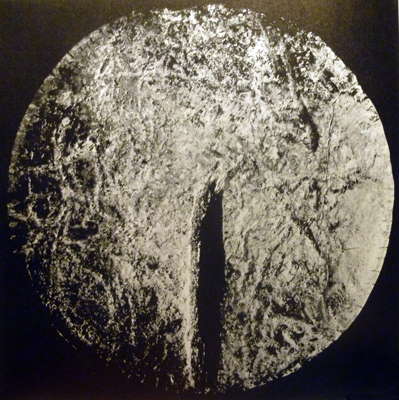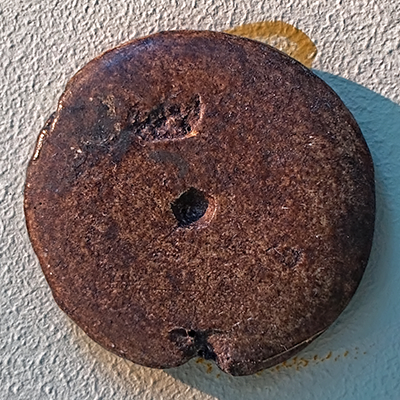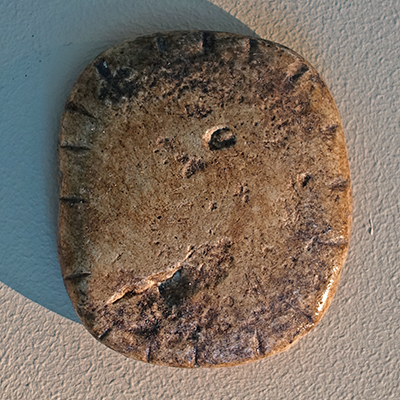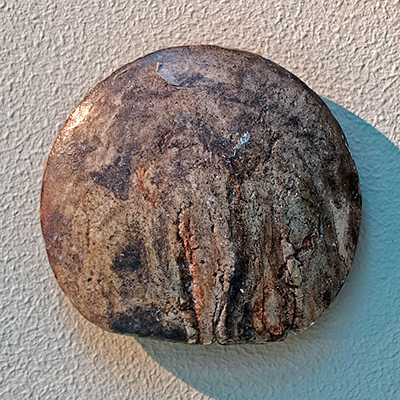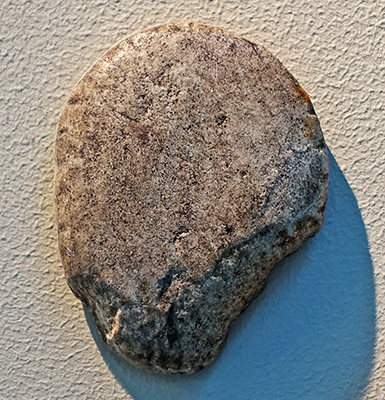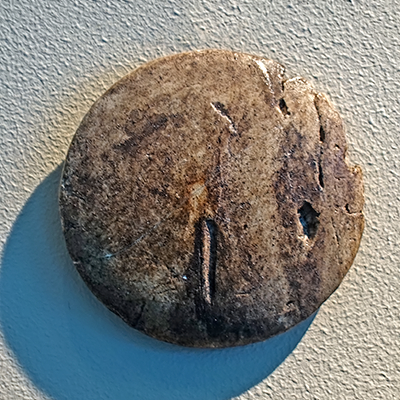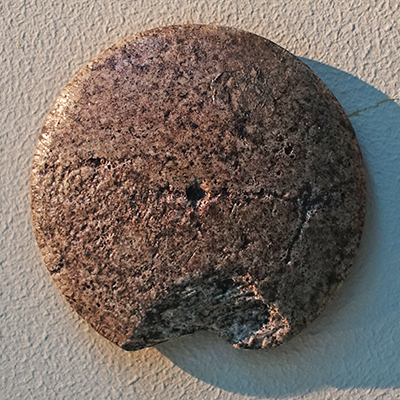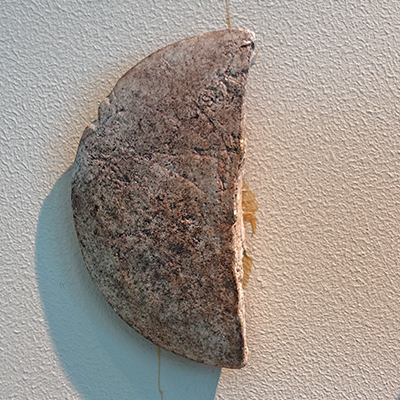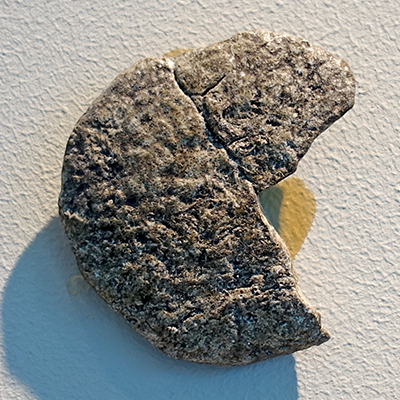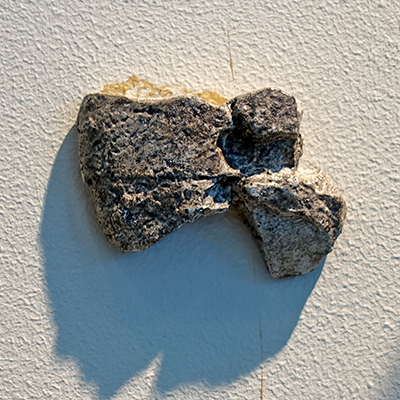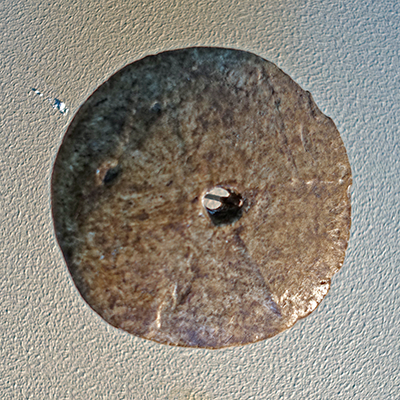The Vulva in Stone Age Art
The vulva is well represented in Palaeolithic art. It is mostly seen as engravings on stone, bone or ivory. The representation is obviously a well known one that has become abstracted to the point where it is often no more than an oval or circle with a single mark at its centre or at its lower edge. Although many examples are from Europe, and from the upper Palaeolithic, it occurs over a broad time range, and a very large area, including not just Europe, but Australia as well.
Vulva, Brno
A disk made from a mammoth molar found in the grave of a shaman at Brno (Moravia) representing an abstract vulva composed of a circle and a line.
There are engraved decorations around the edge. East Gravettian or Pavlovian.
Photo (left) and text: Marshack (1972)
Photo (right): Don Hitchcock 2018
Source (right): Original, Anthropos Pavilion/Moravian Museum, Brno, Czech Republic
The vulva consists of the external genital organs of the female mammal. The vulva has many major and minor anatomical structures, including the labia majora, mons pubis, labia minora, clitoris, bulb of vestibule, vulval vestibule, greater and lesser vestibular glands, and the opening of the vagina. Its development occurs during several phases, chiefly during the fetal and pubertal periods of time. As the outer portal of the human uterus or womb, it protects its opening by a "double door": the labia majora (large lips) and the labia minora (small lips). The vagina is a self-cleaning organ, sustaining healthy microbial flora that flow from the inside out; the vulva needs only simple washing to assure good vulvovaginal health, without recourse to any internal cleansing.Definition of the vulva above: Wikipedia
The vulva has a sexual function; these external organs are richly innervated and provide pleasure when properly stimulated. In various branches of art, the vulva has been depicted as the organ that has the power both to "give life" (often associated with the womb), and to give sexual pleasure to humankind. The vulva also contains the opening of the female urethra, but apart from this has little relevance to the function of urination.
Carved and engraved vulval images from the Upper Palaeolithic.
a) Bodrogkeresztur, Hungary, East Gravettian
b) Laussel
c) Lalinde
d) La Ferrassie
e) La Ferrassie
f) Les Combarelles
g) Pergouset
h) La Ferrassie
Photo: Marshack (1972)
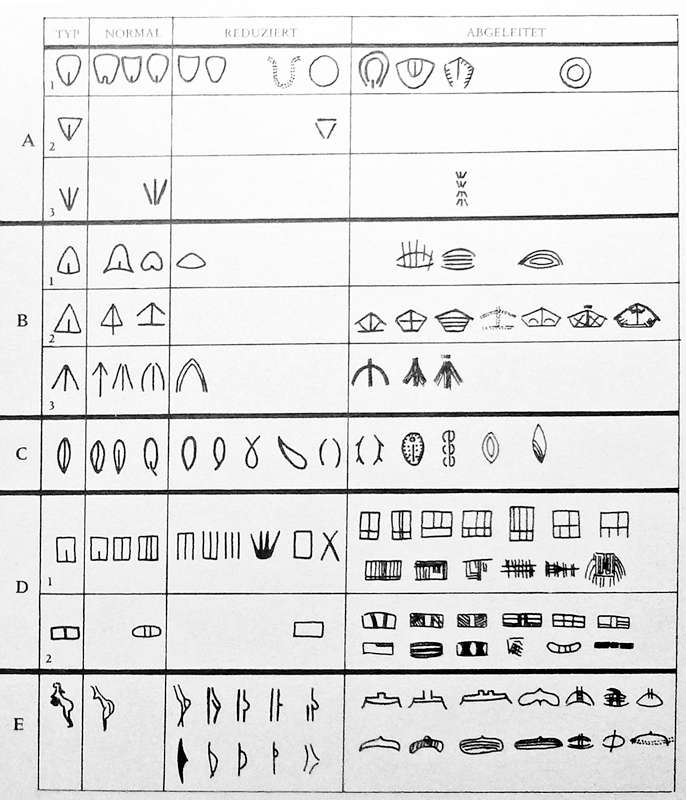
Typology of female characters
A and B triangular sign
In A3 and B3 the 'Wounds' or 'Arrow' characters may be seen as vulvas. The derived forms of B correspond to some tectiform characters from the Eyzies area. Other variants are among the derivatives of E.
C Oval characters
D Rectangular characters
D1 group Perigord - Pyrenees
D2 Cantabrian group
E Claviforme characters
This table shows only typologically matching examples. Of course there are the derived forms (especially E) between different periods and regions, and numerous borrowings and superimpositions.
Photo and text: Leroi-Gourhan (1973)
Type A Female Characters
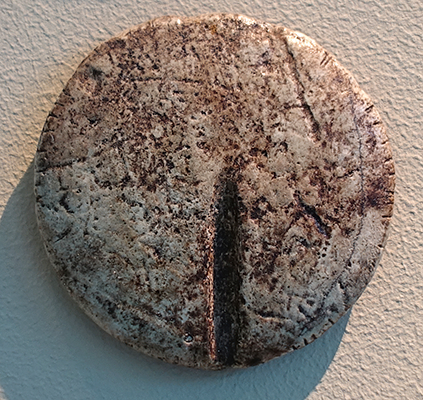
Careful tertiary processing from different raw materials (ivory, mammoth molars, bone, limonite, siltstone) produced objects which symbolised cosmologic phenomena and sexual characters. Certainly they did not serve as ornaments, because they lack the possibility of fixing or hanging.
Delicate cuts on the edges of this object made from a mammoth molar are barely visible to the eye.
It is possibly a magic prop for some esoteric rites, and was found in the grave of the shaman from Brno.
Photo: Don Hitchcock 2018
Source and text: Original, Anthropos Pavilion/Moravian Museum, Brno, Czech Republic
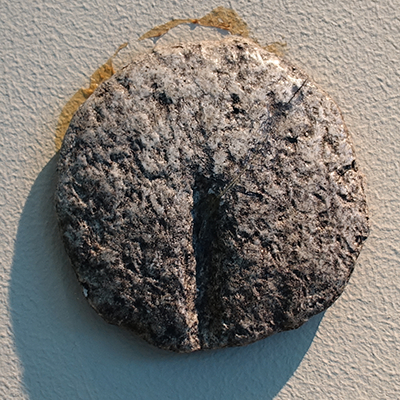
There were a number of vulvae and other magical objects in the grave of the shaman from Brno, as well as the famous puppet.
Photo: Don Hitchcock 2018
Source: Original, Anthropos Pavilion/Moravian Museum, Brno, Czech Republic
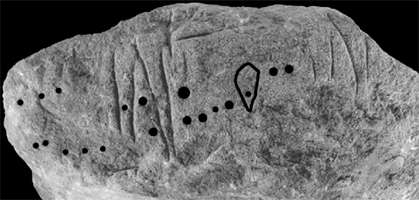
The engraved clast No. 16 from La Ferrassie, Middle
Aurignacian, with the main cupules and the presumed vulva
symbol emphasised
Photo and text: Rock Art Research 2008 - Volume 25, Number 1, pp. 61-100 R. G. BEDNARIK
Les blocs Aurignaciens
Les blocs aurignaciens ont tous été découverts dans une zone circonscrite à une dizaine de kilomètres autour des Eyzies. Outre quelque signes, les thèmes iconographiques, gravés par piquetage pour la plupart, sont de deux types: silhouettes animales difficilement déterminables et représentations sexuelles féminines. Leur datation couvre l'ensemble de la période aurignacienne (plus de cing millénaires), quelques rares exemplaires débordant sur le Périgordien. A la même époque, d'importantes variations régionales apparaissent: en Ardèche par exemple. (Grotte Chauvet-Pont d'Arc), gravures et dessins ont été réalisés en grotte profonde.
Aurignacian (Upper Paleolithic culture between Mousterian and Solutrean, Cro-Magnon man) blocks have been discovered in an area limited to ten kilometers radius from Les Eyzies. In addition to some iconographic signs, engraved by pecking for the most part, there are two types: easily recognised animal silhouettes and female sexual representations. Dating covers the Aurignacian period (more than five millennia), with a few rare examples stretching into the Périgordien. At the same time, significant regional variations appear: for example in the Ardèche, at Chauvet Cave, engravings and drawings were made deep in a cave.
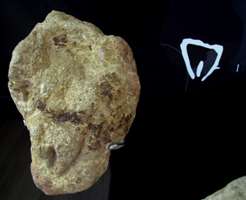
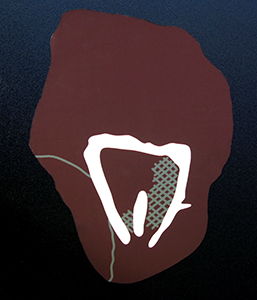
La Ferrassie, Aurignacian sculpture of a vulva.
Photo: Don Hitchcock 2008, 2014
Source: Original, display at Musée National de Préhistoire, Les Eyzies
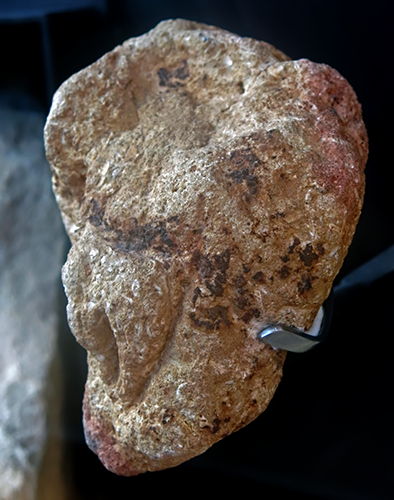
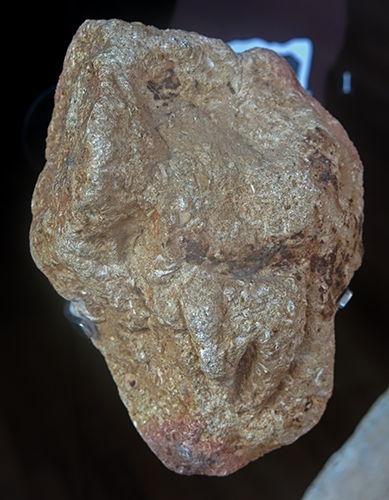
High definition images of an Aurignacian sculpture of a vulva from La Ferrassie.
This is much more of a sculpture than an engraving, with a pronounced three dimensional aspect to the piece, obvious especially in the image on the left.
Photo: Don Hitchcock 2014
Source: Original, display at Musée National de Préhistoire, Les Eyzies
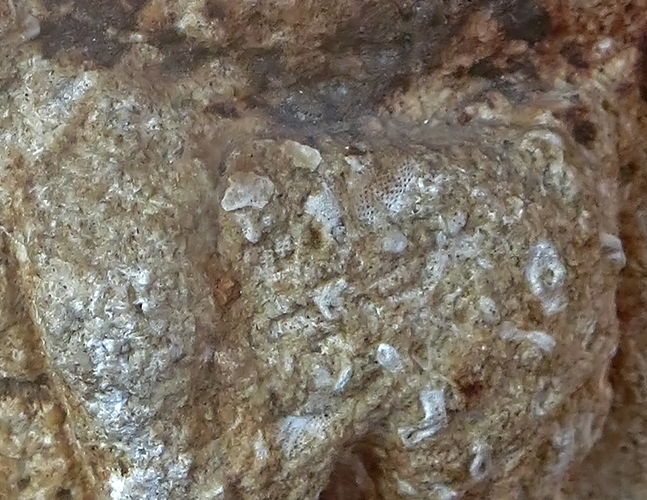
The vulva sculpture above has been carved from a limestone breccia, which may be seen when the thumbnail on the right above (in particular) is clicked to see the full size image.
In the close up at left, we may see pieces of shell and coral (the net-like pattern) embedded in the matrix.
Photo: Don Hitchcock 2014
Source: Original, display at Musée National de Préhistoire, Les Eyzies
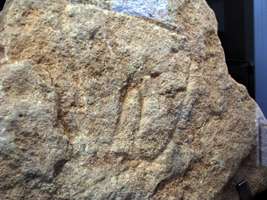
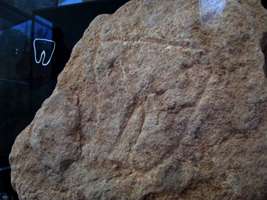
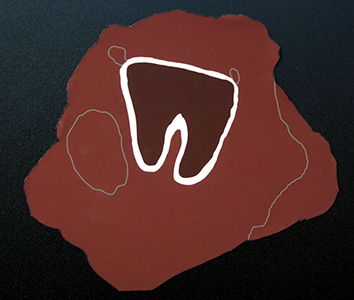
La Ferrassie, Aurignacian engraving of a vulva.
Photo: Don Hitchcock 2008, 2014
Source: Original, display at Musée National de Préhistoire, Les Eyzies
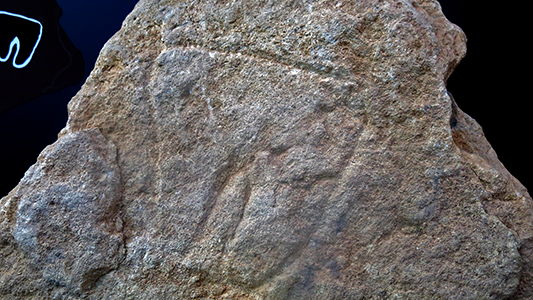
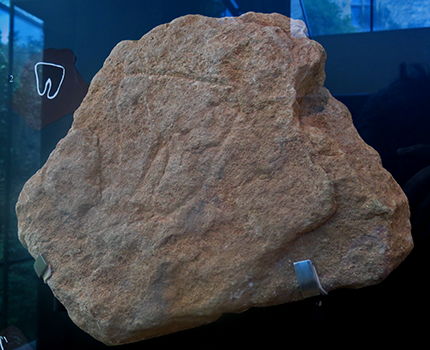
La Ferrassie, Aurignacian engraving of a vulva.
Photo: Don Hitchcock 2014
Source: Original, display at Musée National de Préhistoire, Les Eyzies
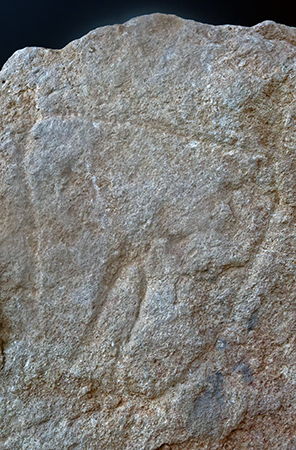
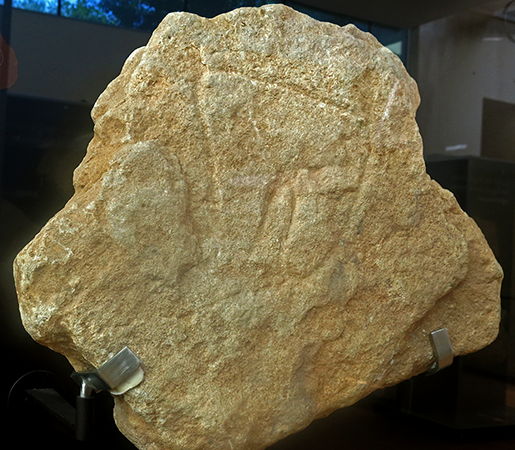
La Ferrassie, high definition images of an Aurignacian engraving of a vulva.
Photo: Don Hitchcock 2014
Source: Original, display at Musée National de Préhistoire, Les Eyzies
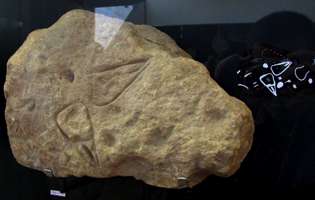
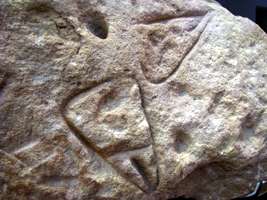
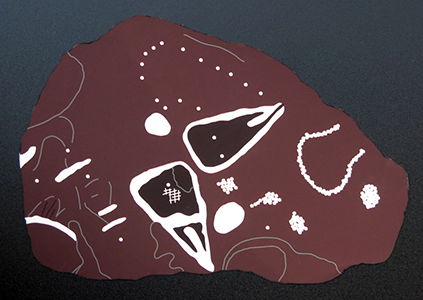
La Ferrassie, Aurignacian engravings of vulvas and cupules.
Photo: Don Hitchcock 2008, 2014
Source: Original, display at Musée National de Préhistoire, Les Eyzies
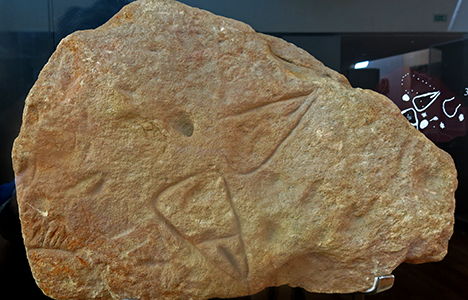
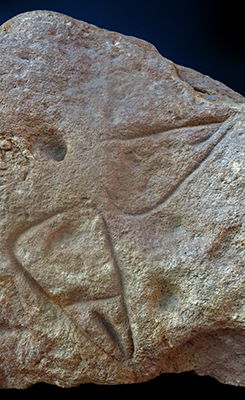
La Ferrassie, high definition images of Aurignacian engravings of vulvas and cupules.
Photo: Don Hitchcock 2014
Source: Original, display at Musée National de Préhistoire, Les Eyzies
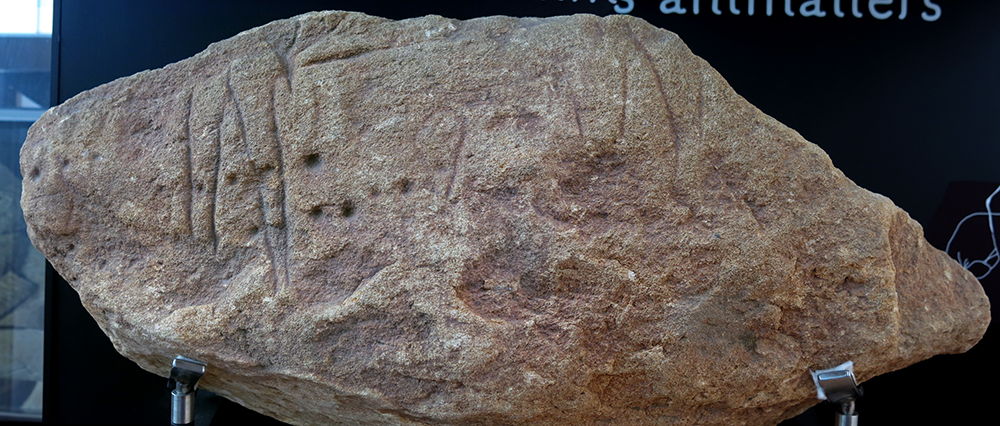
Engraved rock, with the legs of a four footed animal, as well as the outline of a vulva, and many cupules, from Ferrassie.
Photo: Don Hitchcock 2014
Source: Original, display at Musée National de Préhistoire, Les Eyzies
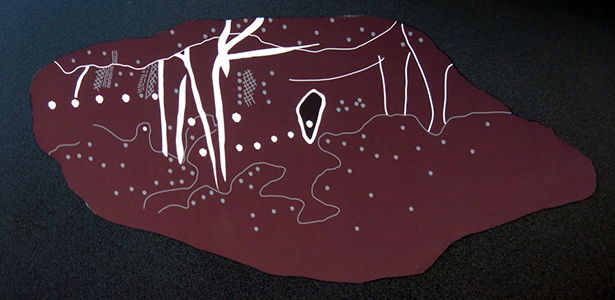
Drawing of the engraved rock above.
Photo: Don Hitchcock 2014
Source: Display at Musée National de Préhistoire, Les Eyzies
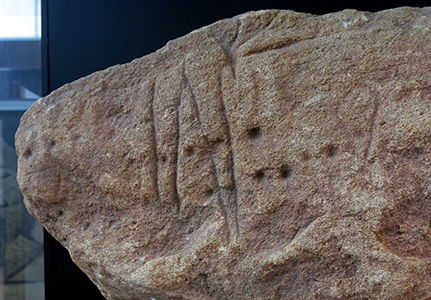
It would seem that the cupules and the vulva have been engraved first, with the legs of the quadruped being added later.
The rock may have originally held the complete outline of an animal, and was subsequently broken in half from side to side.
The vulva and the cupules to the right of it seem very old and faint.
Photo: Don Hitchcock 2014
Source: Display at Musée National de Préhistoire, Les Eyzies
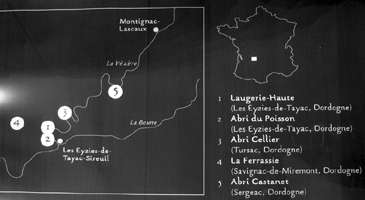
Map showing the position of La Ferrassie and other significant sites with Aurignacian blocks.
Photo: Don Hitchcock 2008
Source: Display at Musée National de Préhistoire, Les Eyzies
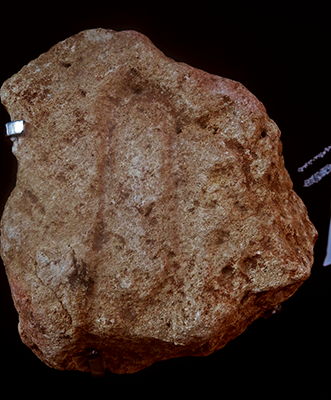
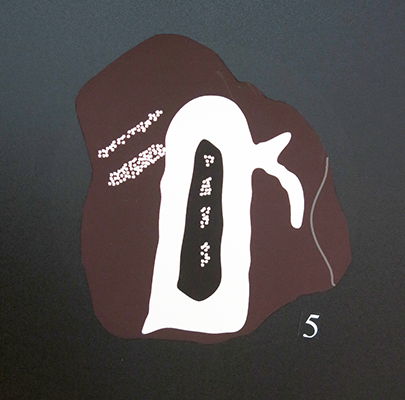
Laugerie Haute East, Perigordian engraving (vulva?).
Number 5 on the display.
Photo: Don Hitchcock 2014
Source: Original, display at Musée National de Préhistoire, Les Eyzies
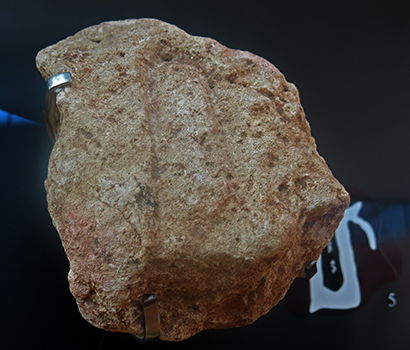
Laugerie Haute East, Perigordian engraving (vulva?).
Number 5 on the display.
Photo: Don Hitchcock 2014
Source: Original, display at Musée National de Préhistoire, Les Eyzies
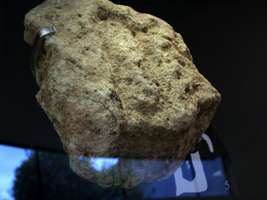
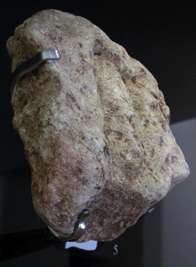
Laugerie Haute East, Perigordian engraving (vulva?).
Number 5 on the display.
Photo: Don Hitchcock 2008
Source: Original, display at Musée National de Préhistoire, Les Eyzies
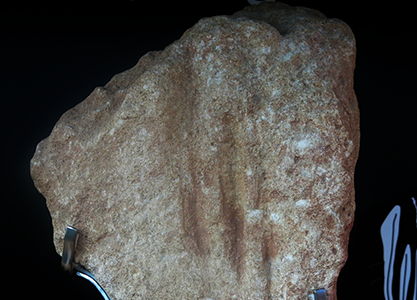
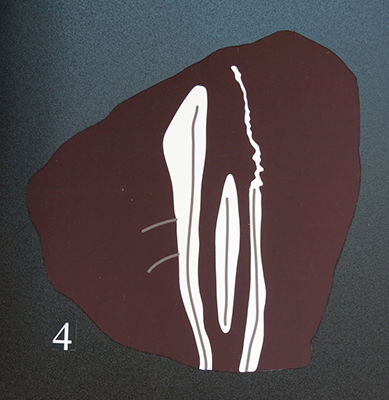
Laugerie Haute West, Perigordian engraving of a vulva.
Number 4 on the display.
Photo: Don Hitchcock 2014
Source: Original, display at Musée National de Préhistoire, Les Eyzies
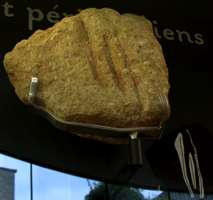
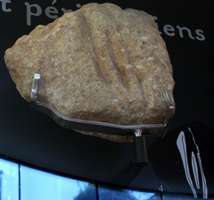
Laugerie Haute West, Perigordian engraving of a vulva.
Number 4 on the display.
Photo: Don Hitchcock 2008
Source: Original, display at Musée National de Préhistoire, Les Eyzies
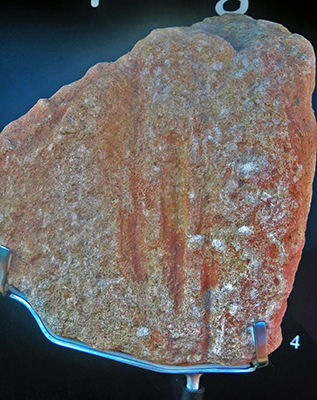
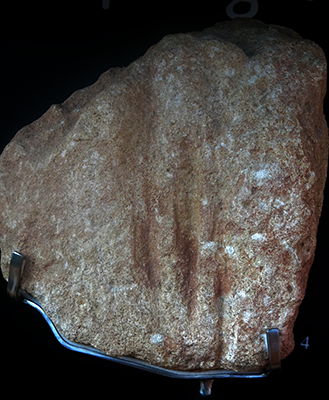
Laugerie Haute West, Perigordian engraving of a vulva.
Number 4 on the display.
Photo: Don Hitchcock 2014
Source: Original, display at Musée National de Préhistoire, Les Eyzies
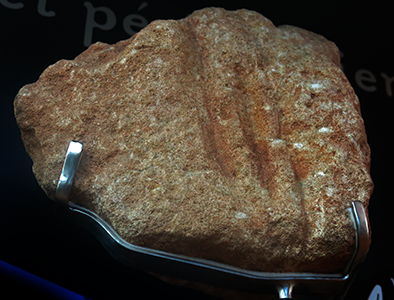
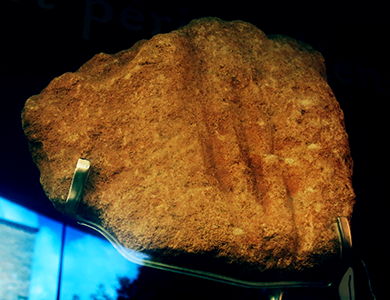
Laugerie Haute West, Perigordian engraving of a vulva.
Number 4 on the display.
Photo: Don Hitchcock 2014
Source: Original, display at Musée National de Préhistoire, Les Eyzies
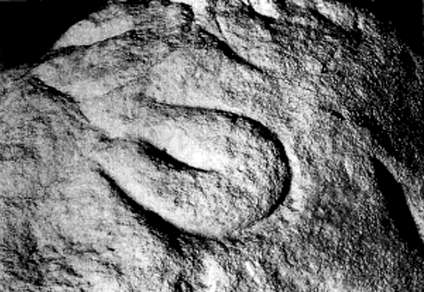
Representation of a vulva carved in a limestone block.
Aurignacian, Abri Cellier
This is the same carving as that shown below (rotated about 130°) on what is known as Bloc 6, on display in the Musée National de Préhistoire, Les Eyzies.
Photo: Eshleman (2003)
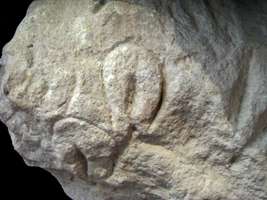
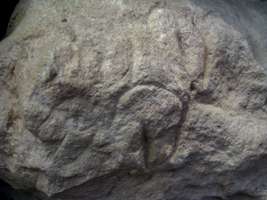
Abri Cellier, Aurignacian vulvas
Photo: Don Hitchcock 2008
Source: Original, display at Musée National de Préhistoire, Les Eyzies
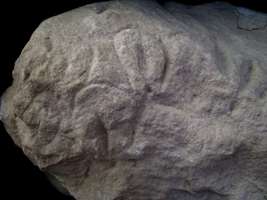
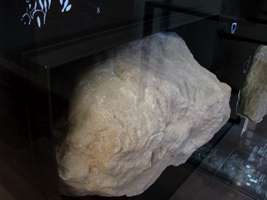
Photo: Don Hitchcock 2008
Source: Original, display at Musée National de Préhistoire, Les Eyzies
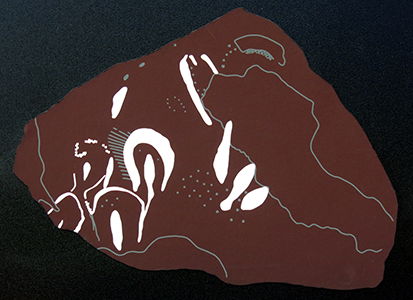
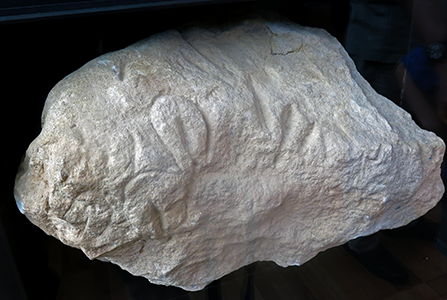
Abri Cellier, Aurignacian vulvas
Photo: Don Hitchcock 2014
Source: Original, display at Musée National de Préhistoire, Les Eyzies
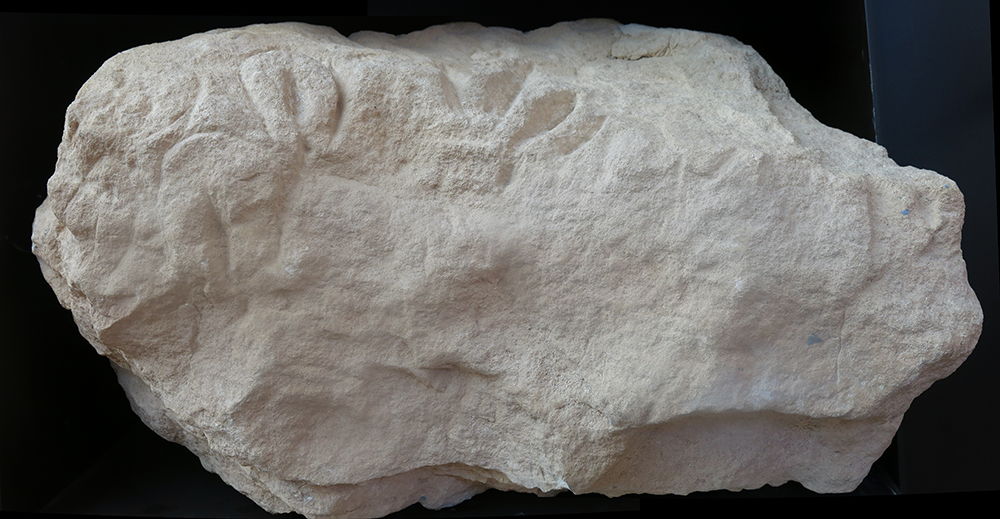
Abri Cellier, Aurignacian vulvas
Photo: Don Hitchcock 2014
Source: Original, display at Musée National de Préhistoire, Les Eyzies
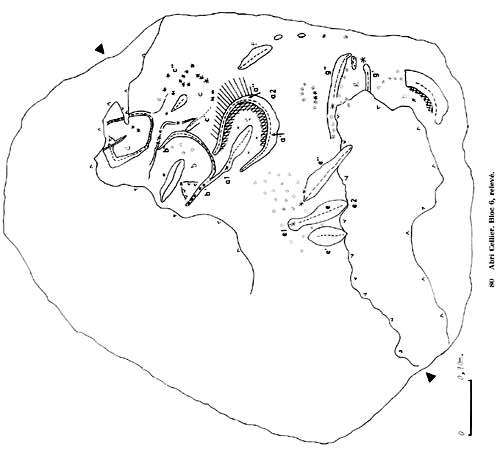
Abri Cellier, Aurignacian vulvas, Bloc 6.
Delineation of the carvings in the Bloc 6 above.
Photo: Delluc (1978)

Abri Cellier, horse with a vulva engraved across the neck.
Photo: www.claytoneshleman.com/matrix.pdf
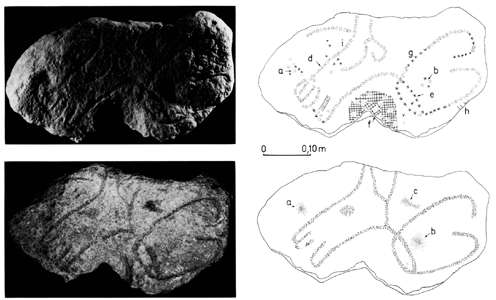
Abri Cellier, horse with a vulva engraved across the neck. This is known as bloc 2.
Above, the engravings on the stone. Below, the engravings highlighted.
Photo: Delluc (1978)
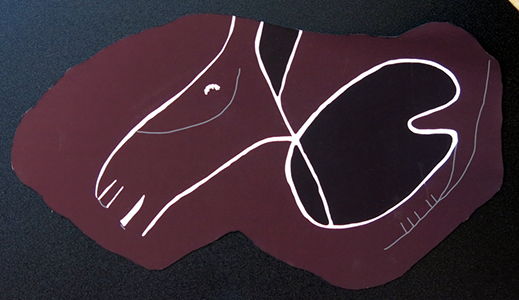
Drawing of the abri Cellier horse.
Photo: Don Hitchcock 2014
Source: Display at Musée National de Préhistoire, Les Eyzies
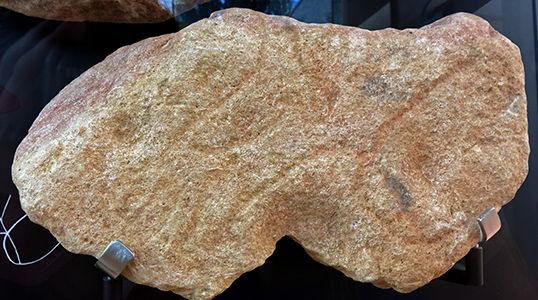
Abri Cellier, horse with a vulva engraved across the neck.
Photo: Don Hitchcock 2014
Source: Original, display at Musée National de Préhistoire, Les Eyzies
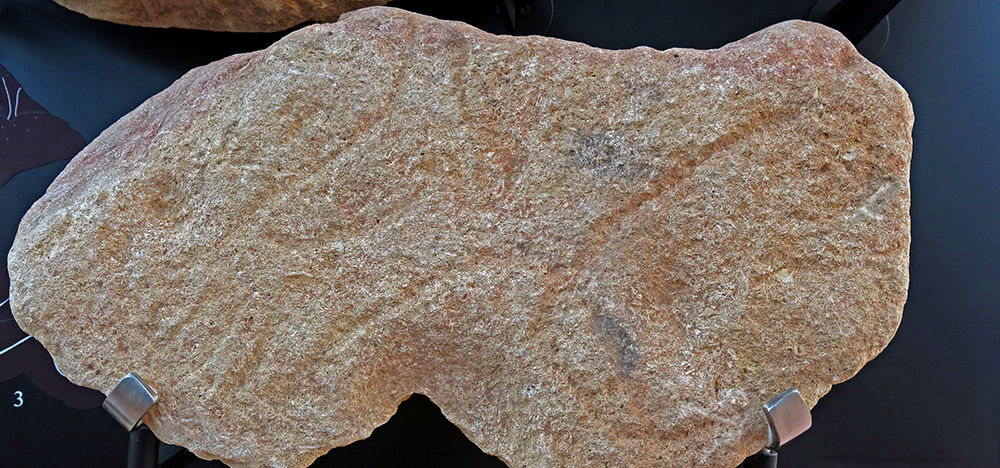
Abri Cellier, horse with a vulva engraved across the neck.
Photo: Don Hitchcock 2014
Source: Original, display at Musée National de Préhistoire, Les Eyzies
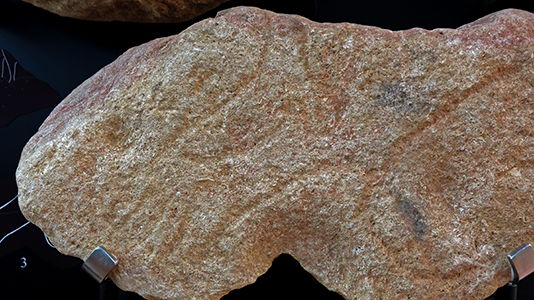
Abri Cellier, horse with a vulva engraved across the neck.
Photo: Don Hitchcock 2014
Source: Original, display at Musée National de Préhistoire, Les Eyzies
This bloc, like all those of the Abri Cellier, was discovered by G. L. Collie in 1927. It was found on the surface of Layer II of Collie, Layer A of Peyrony, with the engraved face turned towards the bottom. For Peyrony, he remarked that it is a stone much less voluminous, carrying a bizarre design. The image appears to be the head of a horse, and on the right a vulva not well represented. These designs are united by a line which seems to indicate a real relation existed between the two.
The block is a thick piece of limestone, 11 cm average thickness, subhexagonal shape, the side faces vertical or slightly oblique. The base is horizontal. The engraved upper face (48 cm x 26 cm) presents two major accidents peripherals.
The top left edge is truncated by an oblique plane whose connection with the horizontal plane of the upper surface is blunt. This oblique plane is affected by burning. This is not an accident after Palaeolithic decoration. In the middle, the bottom edge is presented as an internal angle. The apex of this angle is close to the geometric center of a bowl with a flat bottom, one third has disappeared.
This bowl or large cup, tapered, was obtained by a narrow pick whose impacts are so regular and so close to each other, we can speak of modelling by pecking. This bowl is important as it has localized red marks on the back and sides. This coloration of the rock is absent in its immediate vicinity, but occurs also at the center of the face and along its upper edge, center and left. It may be seen also, in places, on the bottom and the side faces of the block. It evokes, above all, a color of limestone, light tan naturally, near a heat source. It is likely that this block was in the vicinity of a hearth.
The hypothesis that it was a lamp seems less acceptable, because the bowl does not have black marks. However we must note three small blackish spots. Two very diffuse, circular in shape, are located at two irregular pitted cups. The third, elongated, is located in the upper right quadrant, is black and more sustained.
Text above from Delluc (1978)
A flat stone, roughly rectangular, 54 cm by 25 cm (fig 5, No. 1) presents, on a longitudinal edge, three figures of which one (c) is a pubic triangle with softened angles, or maybe just an external genital organ (b and d) while (a) is located on the opposite side, more deformed, referring to the same subject. Behind this last, on the edge of the stone, we can see seven regular grooves. On the left a deep and very regular cupule (e) is in connection with these drawings.
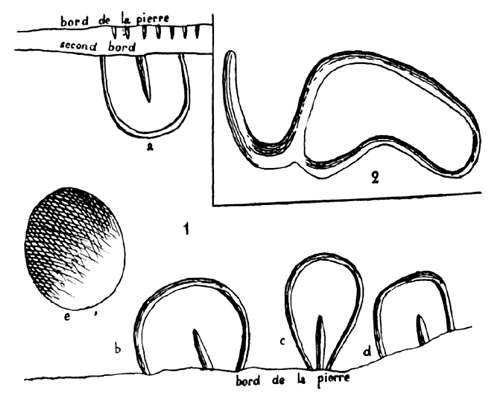
Figure 5
Abri Cellier - Vulvas, a cupule, and a penis.
Photo: Peyrony (1946)
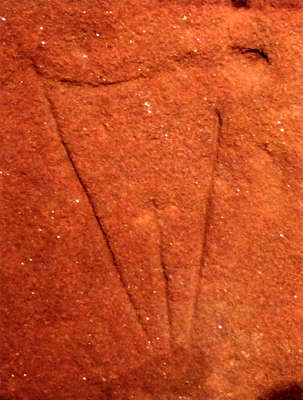
Female sexual triangle engraved on a sandstone block found in Ölknitz Cave, Thuringia.
Height 48 cm.
Photo: Cook (2013)
Source: Landesmuseum für Ur- und Frügeschichte Thüringens, Weimar.
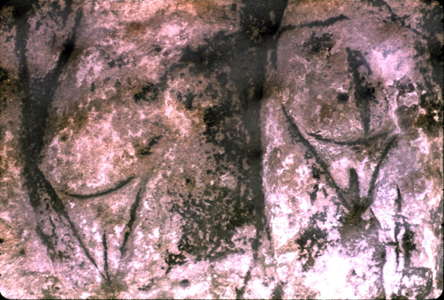
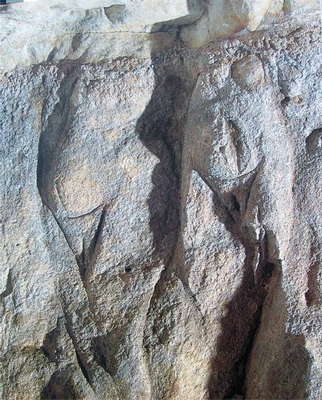
Female sculptures at Roc-aux-Sorciers.
On the left, a photo of two female figures taken through the wire mesh that protected the site in the mid 1960s. The sculptures were created, in part, at the expense of animal representations previously executed.
Photo and text (left): © 2008 Joël Jalladeau
Source (left) : http://jalladeauj.fr/sorciers/index.html
Photo (right): http://www.atramenta.net/lire/les-figures-humaines-dans-lart-paleolithique/23919
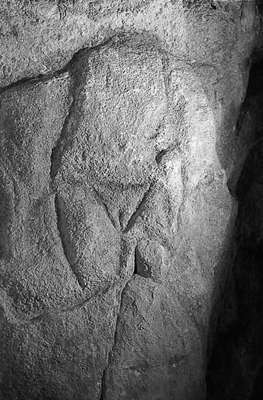
Venus 4 from Roc-aux-Sorciers, Upper Paleolithic ca 14 000 BP.
Photo: http://ushishir.tumblr.com/post/674127014/venus-4-from-le-roc-aux-sorciers-cave-upper
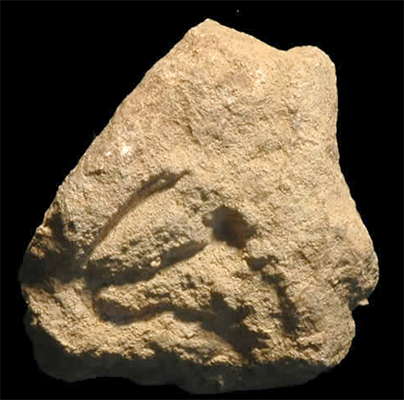
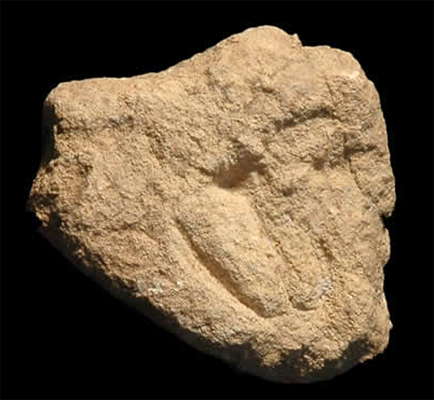
Vulva, Le Roc-aux-Sorciers, cave Taillebourg.
Material and technique: Limestone.
Length: 79 mm; width : 90 mm; thickness : 30 mm.
Conservation status: Limestone block with shaped edges, old fractures.
Provenance: Rousseau Collection.
Decor technique: Sculpture, wide and deep engraving.
Centred on the surface of the block with shaped edges, the engravings are very deep and wide in a triangular pattern marked by a midline incision suggesting a pubic triangle. A cupule interrupts the line of the upper edge of the triangle. The line indicating the vulva extends beyond the contour of the triangle and reaches the edge of the block. The right side of the deep carving is not straight and brings an ambiguity of reading if you turn the object to the left.
Comment: This object is the only sculpted element identified by Lucien Rousseau during his excavations.
Photo: Bloc sculpté (BDD 344): vulva
© Jacques Lemounier, ill. Alain Maulny, 2008.
Text: Geneviève Pinçon Dernière modification de la notice : 2008-07-18
© Réunion des musées nationaux – 2009
Source: http://www.catalogue-roc-aux-sorciers.fr/
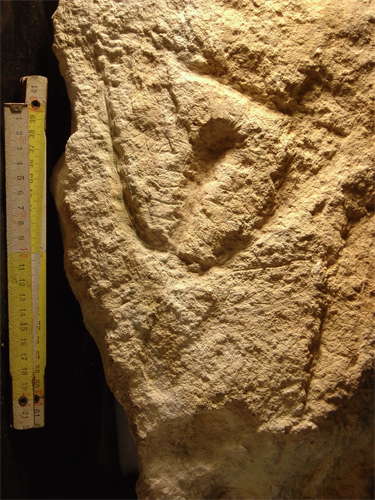
Vulva, Le Roc-aux-Sorciers, cave Taillebourg.
Bloc R37, BDD 123, Face B.
Material: Jurassic oolitic limestone, good condition.
Length 77 cm, Width 39 cm, width 35 cm.
Collection Saint-Mathurin.
Photo and text: © MAN, Geneviève Pinçon, ill. Geneviève Pinçon, 2004.
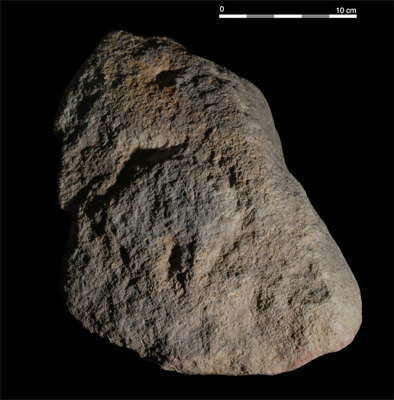
A vulva from Abri Castanet, showing the relief by careful lighting.
Photo: © Raphaëlle Bourrillon
Source for the photo: http://www.livescience.com/20278-gallery-europe-oldest-rock-art.html
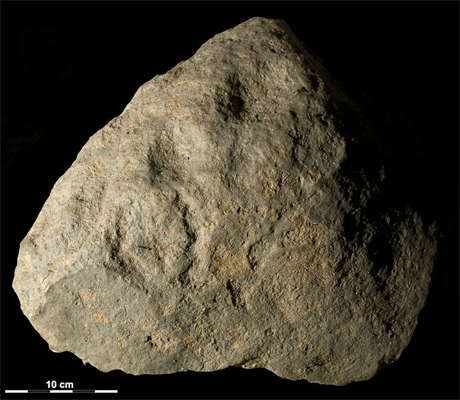
Another vulva from Abri Castanet, showing a vulva on a triangular piece of rock.
Photo: © Raphaëlle Bourrillon
Source for the photo: http://www.livescience.com/20278-gallery-europe-oldest-rock-art.html
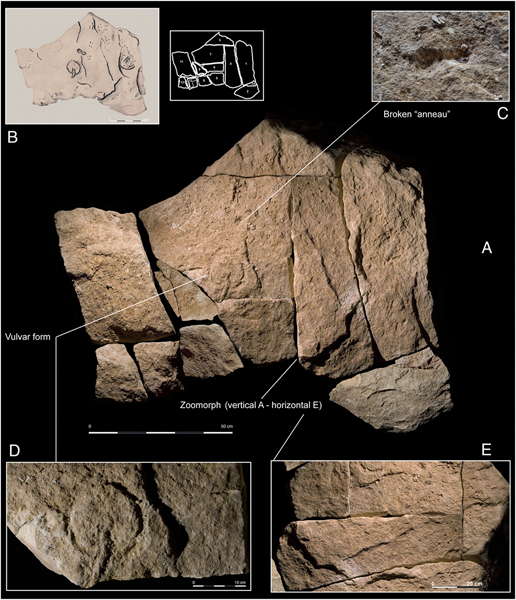
Abri Castanet, Block K.
(A and B) Arrangement of fragments 1–13 of the engraved surface in contact with the archaeological layer.
(C) Broken anneau.
(D) The principal engraved figure.
(E) Detail of zoomorphic figure (rotated 90°).
Photo and text: White et al. (2012)
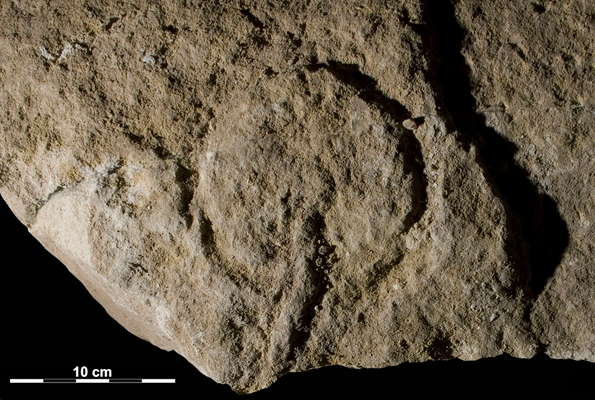
Vulva from Abri Castanet, shown above as part of block K.
This engraving of a vulva comes from Abri Castanet. It has been dated to 37 000 BP, a similar age to the magnificent paintings of the Grotte Chauvet.
A 1.5 tonne piece of limestone was first discovered by Dr Randall White in 2007, where it was found face down on the floor of the abri. The block of limestone was broken up into smaller chunks to be lifted off, when the engraving was discovered.
"Unlike the Chauvet paintings and engravings, which are deep underground and away from living areas, the engravings and paintings at Castanet are directly associated with everyday life, given their proximity to tools, fireplaces, bone and antler tool production, and ornament workshops," Dr White said.
The works in Chauvet and Castanet are both products of the Aurignacian culture, the first modern humans in Europe that replaced the Neaderthals and lived 40 000 to 28 000 years ago. The inhabitants of Abri Castanet hunted reindeer, horse and bison.
"They had relatively complex social identities, communicated through personal ornamentation, and they practiced sculpture and graphic arts," White said.
Photo: © Raphaëlle Bourrillon
Text: an amalgam from a large number of newspaper sources, all drawing on the same NYU press release, from http://www.nyu.edu/about/news-publications/news/2012/05/14/anthropologists-discover-earliest-form-of-wall-art.html
Source for the photo: http://www.ibtimes.com/articles/340938/20120514/female-genitalia-rock-carvings-europe.htm
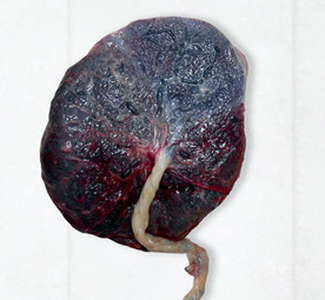
The 'vulva' above is not the usual type of engraving of a vulva. There appears to be a cord leading out from the centre of it, something which does not appear on any vulva engravings I have seen.
What it looks like is a placenta, as shown here.
My thanks to Ralph Frenken for pointing this out.
Photo: http://img.fotocommunity.com/Schwangerschaft/und-die-Zeit-danach/baby-mit-Plazenta-a18228790.jpg
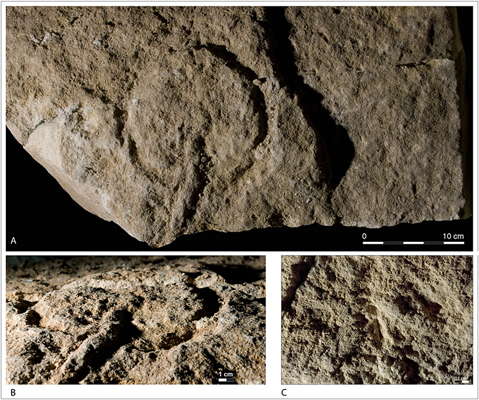
Abri Castanet, Block K.
The principal engraved figure (A) with macro views of engraving (B) and surface preparation (C).
(note that the 'cord' from the vulva is well defined in this photograph, and is about 15 mm wide and 10 mm high - Don )
Photo and text: White et al. (2012)
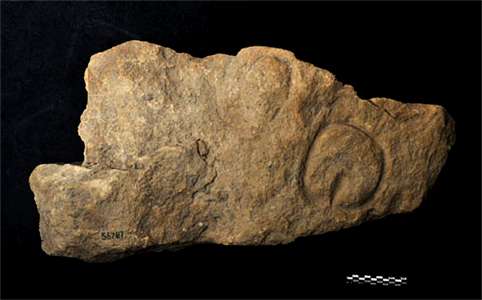
Limestone block carrying two images of vulvas engraved on the stone, from l'abri Blanchard.
© Musée d'archéologie nationale.
Photo: http://www.creap.fr/imgsExpo/expo-module2.htm
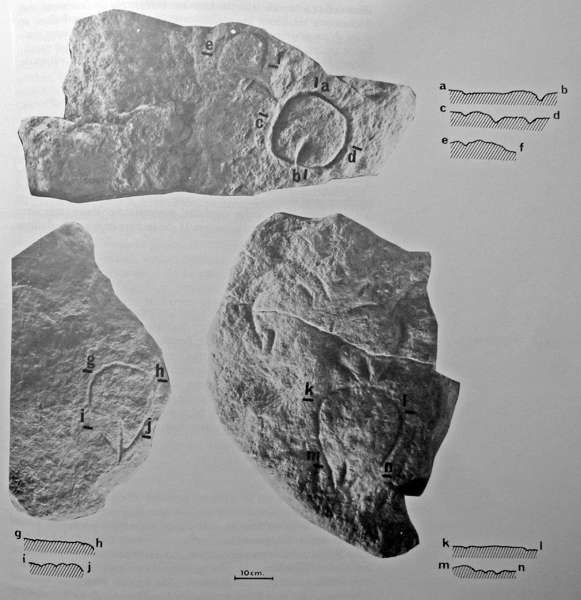
Engravings of vulvas from l'abri Blanchard.
The top block in this photo is the same as the one in the coloured image above.
Photo: Delporte (1979)
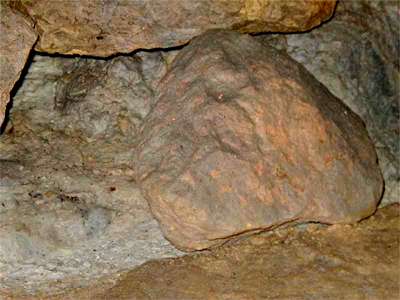
Engraving of a vulva symbol on a limestone block from Abri Labattut, shown here at Abri Blanchard.
Photo: http://www.svnw.de/bericht/praehistorie.htm
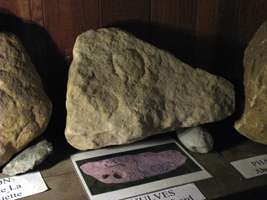
Engraving of a vulva from Abri Blanchard.
Photo: Don Hitchcock 2008
Source: Original, Musée de la préhistoire à Sergeac
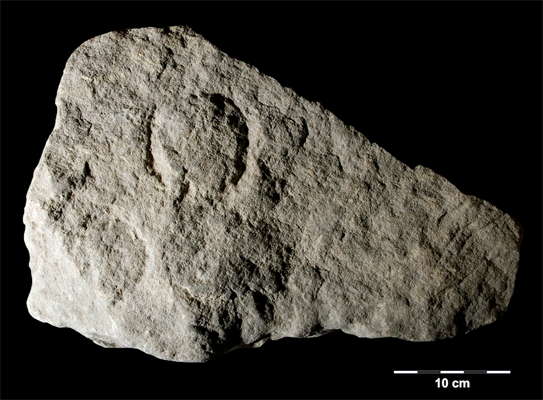
Yet another vulva from Abri Castanet showing a section of the limestone on which it was engraved.
Note that I believe M. Castanet had identified it as coming from Abri Blanchard, as in my photo above.
There may be two other, fainter images of vulvas below this one, and there appear to be other engravings on the right hand side.
Photo: © Raphaëlle Bourrillon
Source for this photo: http://www.livescience.com/20278-gallery-europe-oldest-rock-art.html
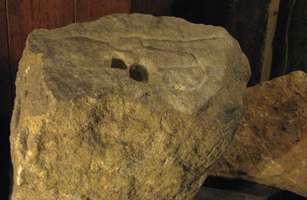
Engraved block, with the 'ring' of a Pierre à Anneau, and a vulva.
Photo: Don Hitchcock 2008
Source: Original, Musée de la préhistoire à Sergeac
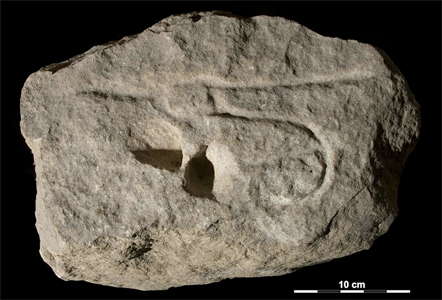
This is a decorated Pierre à Anneau from Abri Castanet, the same piece as in my photo above, but from a different angle.
Pierres à Anneaux were heavy blocks of limestone which had been tunnelled through to form a 'handle' which could then be used to tie down the bottom of the hide curtains used in the Blanchard - Castanet complex to keep out wind.
This one has been decorated with what is described as female genitalia.
Photo: © Raphaëlle Bourrillon
Source for the photo: http://www.livescience.com/20278-gallery-europe-oldest-rock-art.html
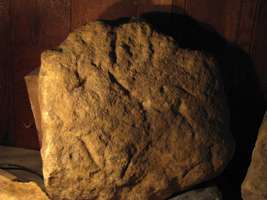
Engraved block, vulvas.
Photo: Don Hitchcock 2008
Source: Original, Musée de la préhistoire à Sergeac
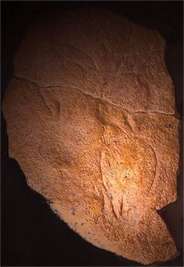
Engraved block, vulvas.
Dated Aurignacian
L'Abri Blanchard
Photo: http://adamcope.blogspot.com/2008_10_01_archive.html

This is a bâton of reindeer antler with vulvas in line from Roc du Marcamps. It illustrates well the shape of the vulvas which the artists drew. In this example, the vulvas are rounded, not triangular, but they are all carefully engraved with a linear V shaped incision.
They are similar to the vulvas from Laussel shown below.
Photo: Don Hitchcock 2015
Source: Original, display at Musée d'Aquitaine à Bordeaux

Lissoir from Laussel, in bone. This bears eroded images of vulvas in the typical Laussel form.
Photo: Don Hitchcock 2015
Source: Original, catalog 61.3.184, Musée d'Aquitaine à Bordeaux
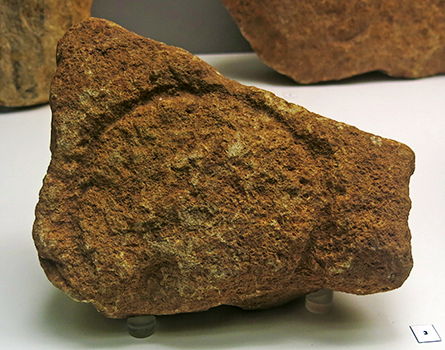
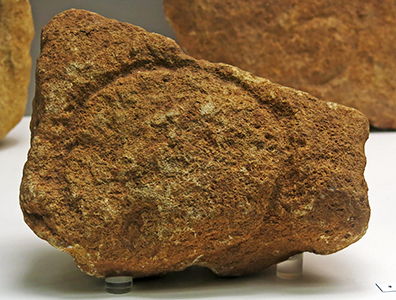
Vulva from Laussel.
Material: Limestone
Age: Aurignacian
Photo: Don Hitchcock 2015
Source: Original, Musée d'Aquitaine à Bordeaux
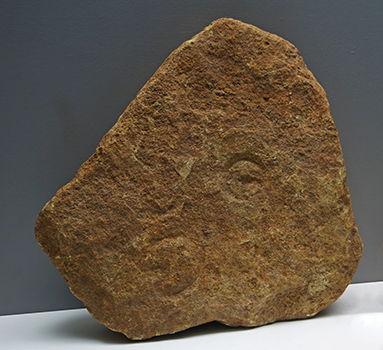
Engraved vulvas from Laussel.
This is Bloc 4 from the paper by Delluc (1978) shown below.
Material: Limestone
Age: Aurignacian
Photo: Don Hitchcock 2015
Source: Original, Musée d'Aquitaine à Bordeaux
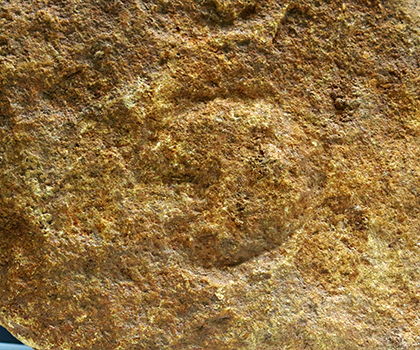
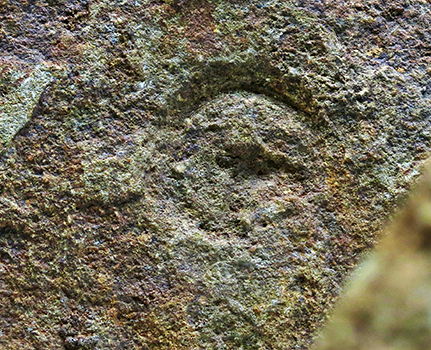
Engraved vulvas from Laussel, closeups of the above.
Material: Limestone
Age: Aurignacian
Photo: Don Hitchcock 2015
Source: Original, Musée d'Aquitaine à Bordeaux
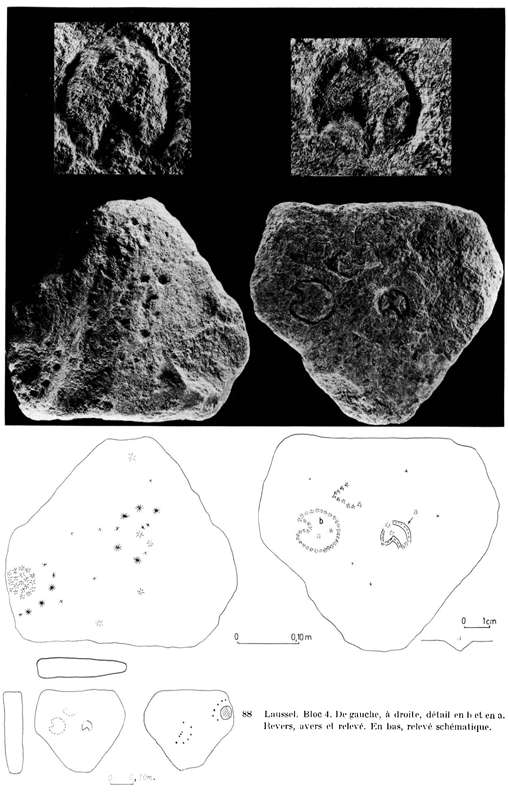
Vulvas, Laussel, from Bloc 4.
Photo: Delluc (1978)
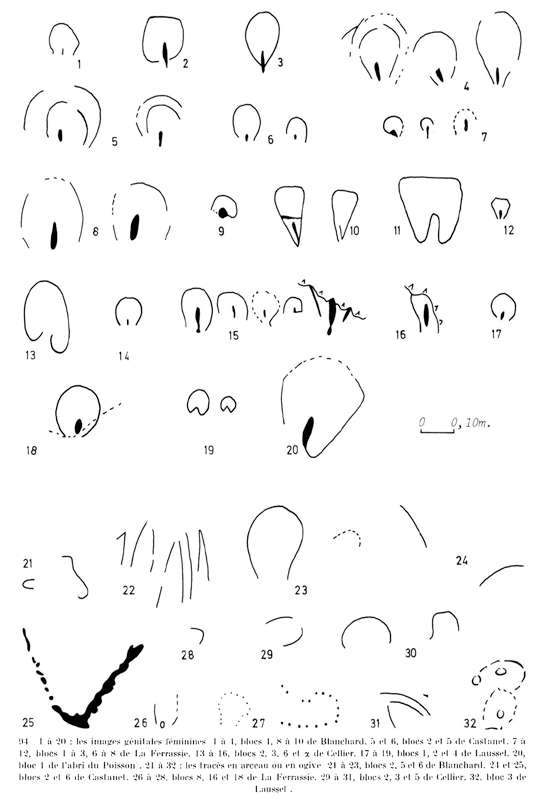
1 to 20: Images of female genitalia
1 to 4: Blocs 4, 8, 9, 10 from Blanchard
5, 6: Blocs 2 and 5 from Castanet
7 to 12: Blocs 1, 2, 3, 6, 7, 8 from La Ferrassie
13 to 16: Blocs 2, 3, 6 and α (Alpha) from Cellier
17 to 19: Blocs 1, 2, and 4 from Laussel
20: Bloc 1 from l'abri de Poisson
21 to 32: Curved lines
21 to 23: Blocs 2, 5 and 6 from Blanchard
24 and 25, Blocs 2 and 6 from Castanet
26 to 28: Blocs 8, 16 and 18 from La Ferrassie
29 to 31: Blocs 2, 3 and 5 from Cellier
32: Bloc 3 from Laussel
Photo and text: Delluc (1978)
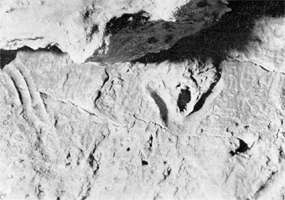
Vulva, Bedeilhac.
A female sexual representation, realistic, deeply drawn by the fingers. The grooves are 25 mm in depth, the maximum width is 120 mm, and the object is 90 mm in height.
The appearance is of a triangle with the bottom up, and clay between the two sides is slightly squashed by the fingers. On the figure are finger marks, apparently intended to represent the start of the pubis. To the left of the vulva can be seen the traces of three fingers together dragged in the clay.
Photo and translated text: after Robert (1946), in Beltrán et al. (1967)
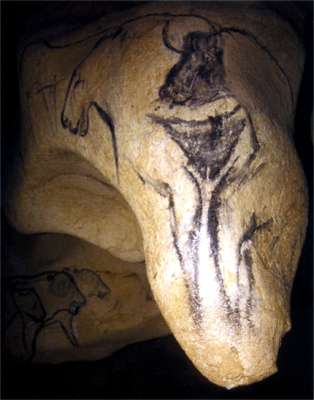
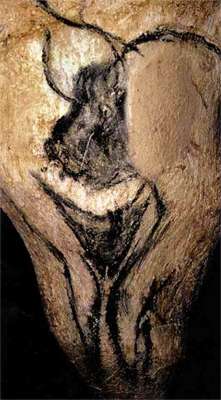
This is a conical pendant from the roof of the cave, and consists of a bison and an exaggerated depiction of a pubic triangle and a vulva, with rudimentary legs ending in points rather than feet. The rock pendant is seen by some as penis like.
The whole ensemble is sometimes known as the sorcerer. Although not visible here, the bison is reported to include a human hand on its lower body.
From: (Left) Chauvet Cave by Jean Clottes, translated by Paul G. Bahn. This book should be on every art lover's bookshelf. The photographs are sumptuous, and the text very informative.
From: (Right) National Geographic, August 2001
Both photos: Yanik Le Guillou
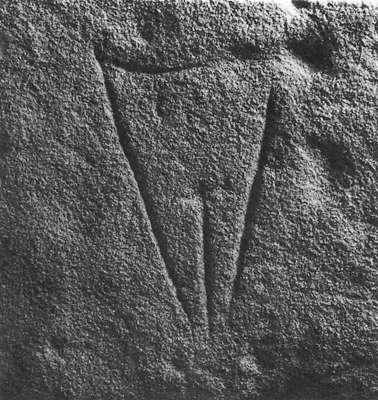
Engraving of a vulva, from Oelknitz.
Photo: Original, Müller-Beck et al. (1987)
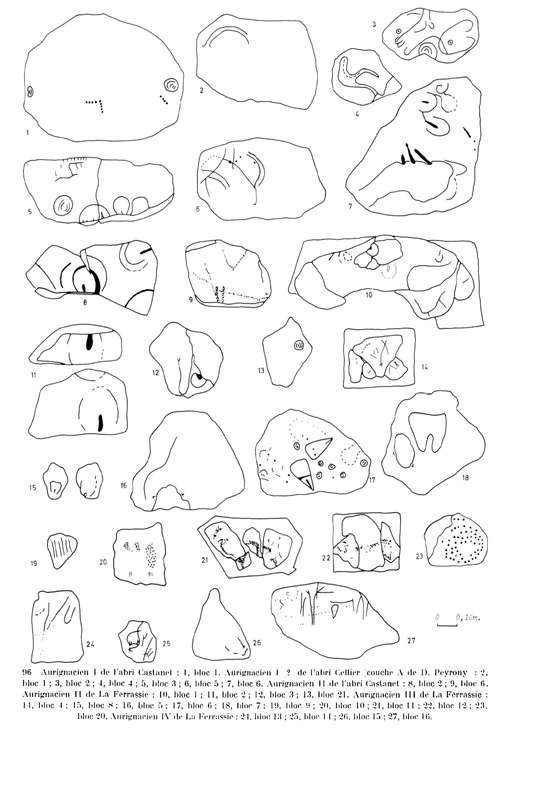
Aurignacian I of l'abri Castanet:
1: Bloc 1
Aurignacian I (?) of l'abri Cellier, bed A of D. Peyrony:
2: Bloc 1
3: Bloc 2
4: Bloc 4
5: Bloc 3
6: Bloc 5
7: Bloc 6
Aurignacian II of l'abri Castanet:
8: Bloc 2
9: Bloc 6
Aurignacian II of La Ferrassie:
10: Bloc 1
11: Bloc 2
12: Bloc 3
13: Bloc 21
Aurignacian III of La Ferrassie:
14: Bloc 4
15: Bloc 8
16: Bloc 5
17: Bloc 6
18: Bloc 7
19: Bloc 9
20: Bloc 10
21: Bloc 11
22: Bloc 12
23: Bloc 20
Aurignacian IV of La Ferrassie:
24: Bloc 13
25: Bloc 14
26: Bloc 15
27: Bloc 16
Photo and text: Delluc (1978)
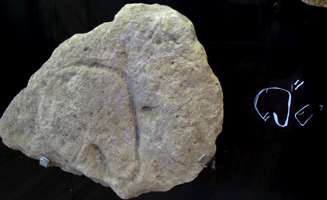
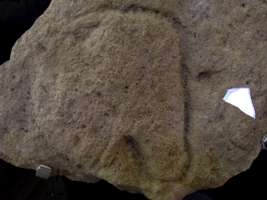
Abri Poisson, Aurignacian engraving of a vulva.
Photo: Don Hitchcock 2008
Source: Original, display at Musée National de Préhistoire, Les Eyzies
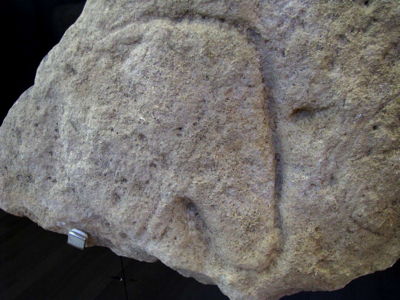
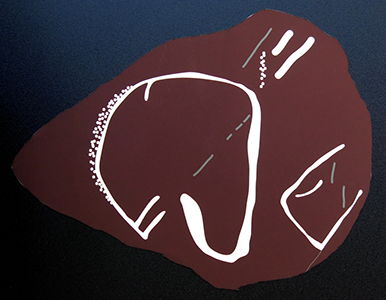
Abri Poisson, Aurignacian engraving of a vulva.
Photo: Don Hitchcock 2008, 2014
Source: Original, display at Musée National de Préhistoire, Les Eyzies
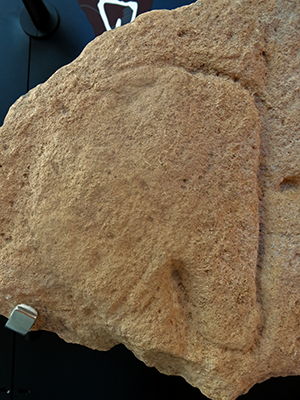
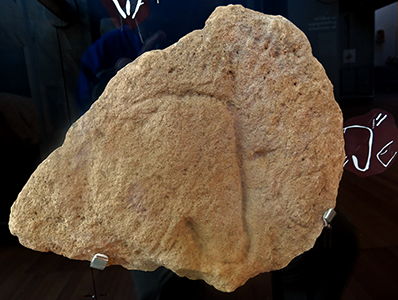
High definition images of the Aurignacian vulva from Abri Poisson.
Photo: Don Hitchcock 2014
Source: Original, display at Musée National de Préhistoire, Les Eyzies
Type B Female Characters
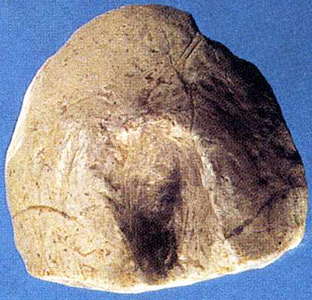
Vulve sculptée de Kostienki 1. Collection MAE. Photo L. Iakovleva.
Vulva sculpture from Kostienki 1. Collection MAE.
Photo and French text: "les mammouths - Dossiers
Archéologie - n° 291 - Mars 2004"
Photograph L Iakovleva.
My thanks to Anya for access to this resource.
Type C Female Characters
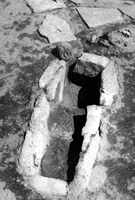
Lepenski Vir Ic - the hearth in house No. 51. At the north east angle of the hearth is a boulder of red sandstone on which a vulva has been carved, shown in the close up photograph below.
Photo: Srejovic (1972)
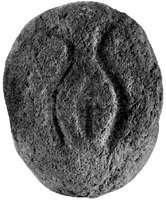
Sculpture from the hearth of house No. 51, Lepenski Vir Ic. It shows a vulva in a specific physiological state, just before giving birth, with all its anatomical details.
Photo: Srejovic (1972)
Type D Female Characters


Laugerie Haute East, Perigordian engraving (vulva?).
Photo: Don Hitchcock 2008
Source: Original, display at Musée National de Préhistoire, Les Eyzies


Laugerie Haute West, Perigordian engraving of a vulva.
Photo: Don Hitchcock 2008
Source: Original, display at Musée National de Préhistoire, Les Eyzies
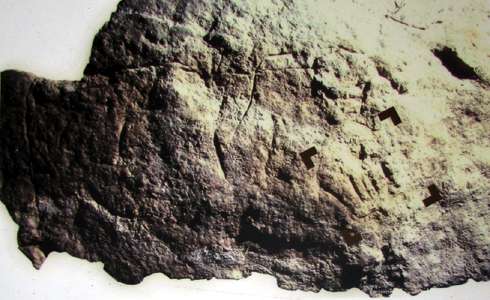
Vulva at Abri Pataud
Gravettien Final (Périgordien VII) - 22 000 ans
Image vulvaire gravée sur un bloc éboulé de la voûte de l'abri. au voisinage du squelette de la jeune femme déposée avec le bébé nouveau-né.
Gravettien Final (Périgordien VII) - 22 000 BP
A depiction of a vulva engraved on a block fallen from the roof of the abri, near the skeleton of the young woman buried with a newborn baby.
Photo: Don Hitchcock 2008
Text: Translated and adapted from a display at the excavation site.
Source: A display at the excavation site.
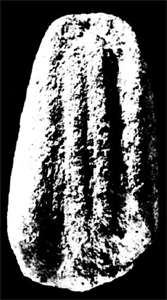
Representation of a glans penis and vulva, Laussel.
Photo: Duhard et Roussot (1988)
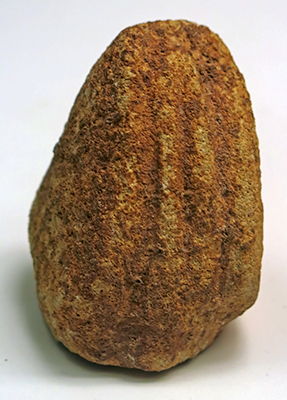
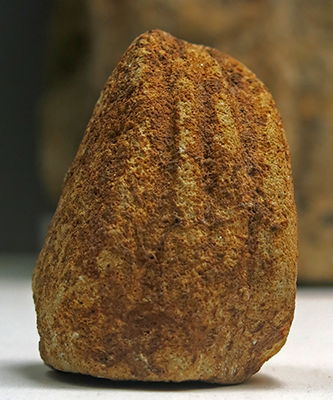
Representation of a glans penis and vulva, Laussel.
Material: Limestone
Age: Gravettian
Photo: Don Hitchcock 2015
Source: Original, Musée d'Aquitaine à Bordeaux
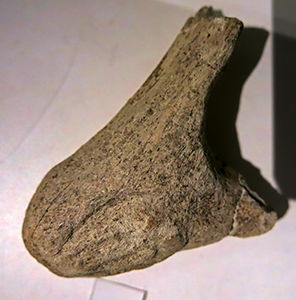
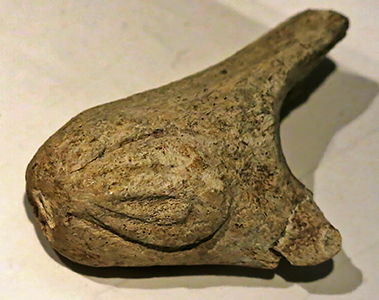
Engraved vulva from Pair-non-Pair.
Material: Reindeer antler
Age: Recent Palaeolithic
Catalog: 60.1070.2
Photo: Don Hitchcock 2015
Source: Original, Musée d'Aquitaine à Bordeaux
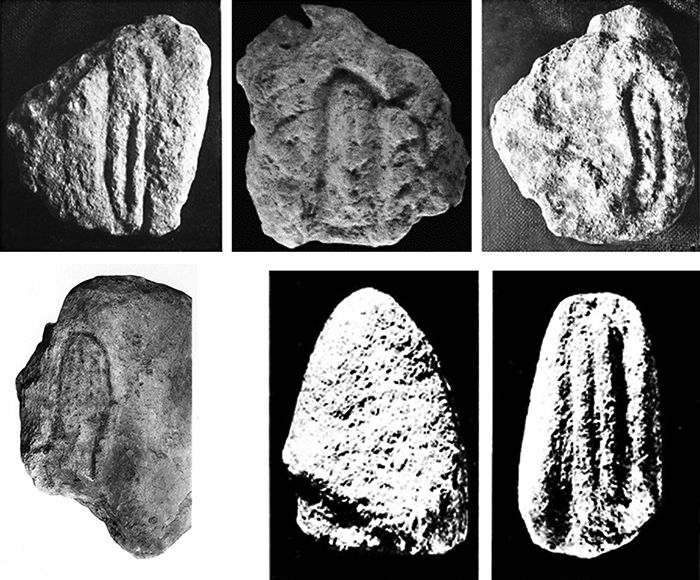
Laugerie-Haute and Laussel Gravettian phalli-vulvas
(top left) Laugerie Haute West Couch-B (source unknown)
(top centre) Laugerie-Haute East Couche-B (photo Don Hitchcock, donsmaps.com)
(top right) Laugerie-Haute East Couche-B (source unknown)
(bottom left) Laugerie Haute West-Couche B (after Peyrony & Peyrony 1938 )
(bottom centre) Laussel, glans penis block (after Duhard & Roussot 1988 : fig. 1)
(bottom right) Laussel, vulva-phallus block (after Duhard & Roussot 1988 : fig. 1)
Collage and text: James Harrod
Source: Unpublished MS, James Harrod
The Vulva as sculpture

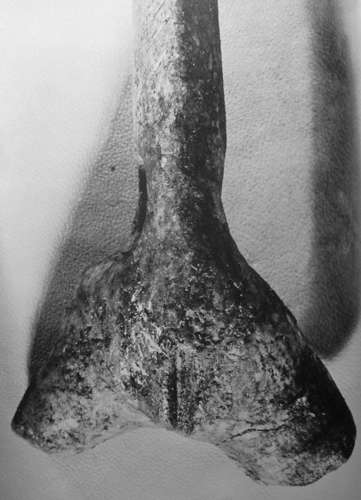
This is one of the very few occasions where the vulva is the main topic of a sculpture, from Placard.
Photo: Marshack (1972)
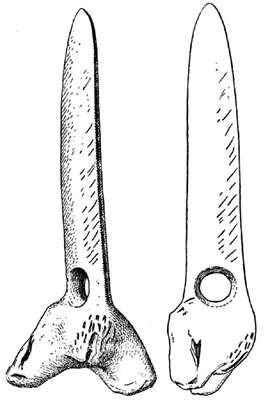
This example is intact. Its total length is 155 mm. It consists of a straight blade with a sharp tip and edges, 12 cm long and 2 cm wide, ending in a strong bulged fork. The blade is pierced at its base with a fairly regular hole of 15mm diameter. Below this hole has been carved female external genitalia in a manner sufficiently clear to leave no doubt.
A bulge, located in the extension of the sharp blade, is the mount of Venus. The lower part carries a strong vertical cut, in which it is easy to recognize the vulvar slit. The top is surrounded by small incisions, which were obviously intended to represent the hair overlying the pubis. Finally, the two stumps, which form the fork, show the start of the thighs.
All this is rather naive, quite coarse, but exactly reproduced. The two objects mentioned were collected in the lower Magdalenian deposits of Placard, in layers 4 and 5, which contained some attempts at sculpture, but no real engravings.
Photo and text: Mortillet (1906)
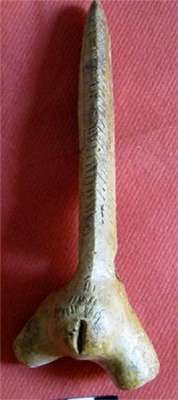
This piece has come to be known as the Venus de la grotte du Placard.
Photo: Giuseppe Novelli, former president of the caving club of Genoa, Italy.
Source: Facsimile, 2010.06.13 via http://speleoclubdelaude.blogspot.com/2010/12/les-venus-prehistoriques.html
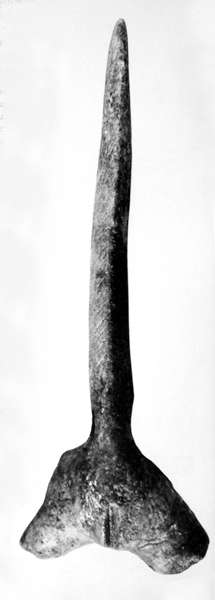
The Placard Venus.
Photo: Marshack (1972)
Source: Original
Australian Stone Age Vulvas
These images are from Carnarvon Gorge, in southern Queensland. The similarity in form with European images of vulvas is astounding.

Another section of the 'Art Gallery' rock shelter.
I call this "The Wall of One Thousand Vulvas".
One of the interpretation signs here says:
The most common engraving found here is of the human vulva. The significance of this motif is not known. Engravings of vulvas are common along the cliffs of the Great Dividing Range in this region. Nowhere else in Australia is this motif engraved in this way with such regularity.
Individual photographs used to make up this panorama are examined in more detail below:
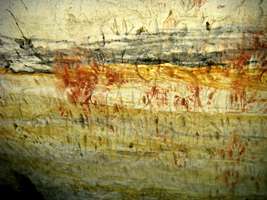
The stencilled hands in this view seem relatively recent, within the last few hundred years, as do most of the paintings on this wall.
Some of the engravings, however, appear to be many hundreds, possibly thousands of years old, judging on their condition.
As well as vulvas, in this view there are engravings of kangaroo and emu tracks.
Photo: Don Hitchcock, August 2009
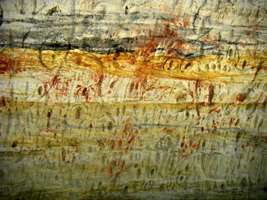
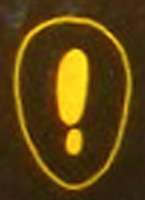
Many of the images of the vulva are as shown in the diagram on the right, rephotographed from the excellent interpretation plaques at the site, with what is apparently a vaginal opening and the smaller urethra.
The vulvas are shown with the larger vaginal opening uppermost, above the urethra. This would indicate that the vulva is shown as it would appear with a woman lying face down.
Another possibility is that suggested to me by Ralph Frenken, that the engravings depict the vagina and anus. If so, these women are not depicted lying on their stomach but simply on their back.
A group of six (possible) emu eggs is shown between two pairs of vulvas in this view. Emu eggs are a common motif in engravings in this area. As well, there are emu tracks engraved, as well as some apparently old engravings of vulvas and other enigmatic engravings rounded by time, especially towards the bottom of the wall near the present ground level.
Photo: Don Hitchcock, August 2009
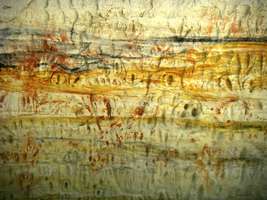
Not all the vulvas have the anatomical detail of the examples above. Some consist of an oval in bas relief, with a comparatively deep depression within.
However two of the vulvas show the anus as well as the vagina.
Photo: Don Hitchcock, August 2009
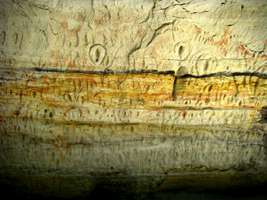
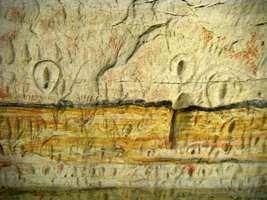
In these views we can see a group of perhaps eight predominantly teardrop-shaped depressions near the prominent vulva to the left. The two other large vulvas on the light coloured sandstone appear to be much older and more eroded than the prominent vulva.
At least three of the vulvas (one being the large vulva on the left) appear to have an anus as well as a vagina marked.
In addition, there are a number of carved emu tracks.
Photo: Don Hitchcock, August 2009
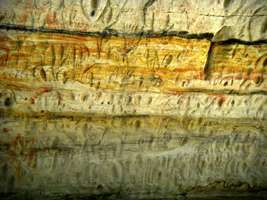
The lower, predominantly grey sandstone shown here may be more easily weathered. Certainly all the engravings on this section appear to be significantly degraded. There are some enigmatic vertical lines in this section.
Photo: Don Hitchcock, August 2009
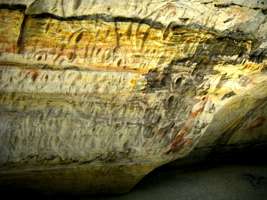
Apart from the ubiquitous vulvas, towards the middle of this view may be seen what appears to be two engraved hands, and on the right, some fairly recent stencils of hands done in red ochre.
In the upper right section of the photograph, an attempt seems to have been made to encircle a large group of engravings with a single groove in the shape of a large oval.
Photo: Don Hitchcock, August 2009
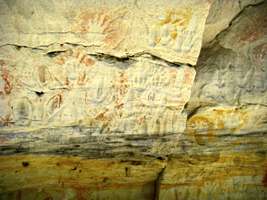
This section has engravings of some large emu tracks, various vulvas, and a group of human hands. In addition, there are stencilled hands in both red and yellow/orange ochre.
Photo: Don Hitchcock, August 2009
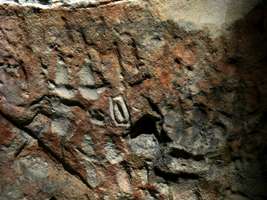
This section of the wall at Cathedral Cave has several ages of engravings, as evidenced by the different amount of patination on the engravings. The most recent are a somewhat angular vulva and what appears to be a pair of kangaroo prints, but there are older engravings which may be of a small four-fingered hand, and other unidentifiable animal prints engraved in the surface.
Photo: Don Hitchcock, August 2009
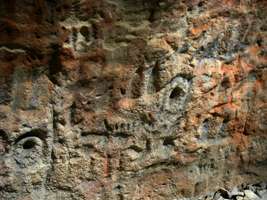
This section of Cathedral Cave has at least two vulvas, as well as a pair of kangaroo prints, an emu print, and a hand engraved on the wall. All have been on the wall long enough to acquire a patina from the weather.
Photo: Don Hitchcock, August 2009
References
- Beltrán, A., Robert, R., Gailli R., 1967: La Cueva de Bédeilhac, Zaragoza 1967
- Cook, J., 2013: Ice Age art: arrival of the modern mind, The British Museum, 18 Feb 2013, ISBN-10: 0714123331, ISBN-13: 978-0714123332
- Delluc, G.&B., 1978: Les manifestations graphiques aurignaciennes sur support rocheux des environs des Eyzies (Dordogne), Gallia préhistoire, Tome 21 fascicule 2, 1978. pp. 333-438.
- Delporte H., 1979: L'image de la femme dans l'art préhistorique, Paris, Picard.
- Duhard J., Roussot A., 1988: Le gland pénien sculpté de Laussel (Dordogne), Bulletin de la Société préhistorique française 1988, tome 85, N. 2. pp. 41-44.
- Eshleman C., 2003: Juniper Fuse: Upper Paleolithic Imagination & the Construction of the Underworld, Wesleyan University Press 2003
- Leroi-Gourhan A., 1973: Prähistorische Kunst: d. Ursprünge d. Kunst in Europa, Herder, 1973 - 601 pages
- Marshack, A., 1972: The Roots of Civilization: the Cognitive Beginning of Man’s First Art, Symbol and Notation New York, McGraw-Hill
- Mortillet A. de, 1906: Deux curieuses pièces de la grotte du Placard, Bulletin de la Société préhistorique française. 1906, tome 3, N. 10. pp. 431-434.
- Müller-Beck, H. and Albrecht, G. (Ed.), 1987: Die Anfänge der Kunst vor 30000 Jahren Theiss: Stuttgart.
- Peyrony D., 1946: Périgord, Gallia, Tome 4, 1946. pp. 294-301.
- Robert, R., 1946: Fouilles à la grotte de Bédeilhac, Bulletin de la Société préhistorique française, 1946, tome 43, No. 9-12. pp. 322-326
- Srejovic, D., 1972: Europe's first monumental sculpture: new discoveries at Lepenski Vir (New aspects of antiquity) , Stein and Day; 1st US edition edition (1972)
Back to Don's Maps
 Back to Archaeological Sites
Back to Archaeological Sites
